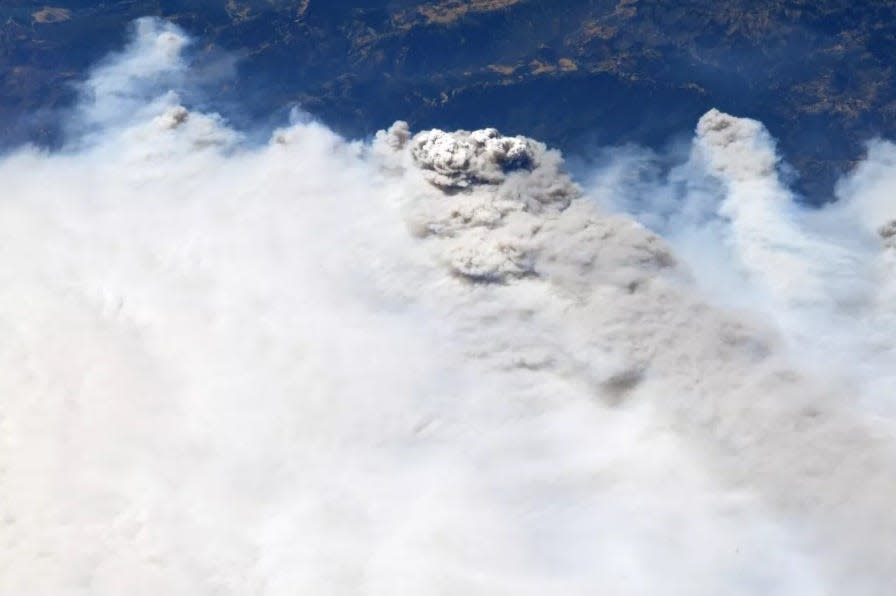California's air quality is worse than India's. That's not good in a pandemic
SAN FRANCISCO – Kevin Galvin, a water conservation administrator who lives in the Oakland foothills, woke up Monday morning to “dry, smoky air with ash in it,” and the house smelled like the site of a campfire.
Millions of his fellow Californians were breathing in that same harmful air.
The hundreds of wildfires ravaging the state, especially the northern and central parts, have badly deteriorated the air quality over large swaths when residents are already at a high risk of pulmonary disease because of the COVID-19 pandemic.
"Most, if not all, major urban areas in California have been affected by poor air over the past week," the California Air Resources Board told USA TODAY, and the highest level of PM2.5 – fine particles that can reach deep into the lungs – were registered in Santa Cruz County and the Monterey Bay region.
As of 2:30 p.m. PDT Monday, about one-third of the Golden State was deemed to have air unhealthy for all members of the general public, according to the Environmental Protection Agency’s Air Quality Index. That assessment included highly populated spots such as the San Francisco Bay Area, Fresno and the capital city of Sacramento.
At times during the past few days, parts of the Bay Area have been blanketed by a thin layer of ash while enduring the worst air quality in the world. According to purpleair.com, Monday afternoon’s rating of 548 west of San Jose was three times higher than the closest global figure.
“The concentration of the tiny particles (PM2.5) in the Bay Area is roughly five times the daily average limit set by the EPA. It's worse in the Bay Area now than mega cities like New Delhi, which are known for poor air quality,” said Coty Jen, assistant professor at the Center for Atmospheric Particle Studies at Carnegie Mellon University. “Even healthy people are reporting headaches, bloody noses, etc., during this current smoke event.”
Finally, a break: Massive wildfires scorch California, but humidity helps keep feared lightning at bay for now
The EPA calculates a daily Air Quality Index based on five major pollutants regulated by the Clean Air Act: ground-level ozone, particle pollution (also known as particulate matter), carbon monoxide, sulfur dioxide and nitrogen dioxide. Fine particles present the most serious health threat, according to the AirNow.gov website.
“These microscopic particles can penetrate deep into your lungs,” the website says. “They can cause a range of health problems, from burning eyes and runny nose to aggravated chronic heart and lung diseases. Exposure to particle pollution is even linked to premature death.”
The EPA warns that surgical and cloth masks and bandannas, often used to prevent spread of the coronavirus, don’t protect against smoke inhalation. Higher-grade N-95 masks do to a large extent, but they’re in short supply and mostly reserved for medical workers.
The Air Resources Board advises people in the affected areas to stay inside with their windows and doors shut, run air conditioners in the recirculate setting and keep track of conditions.
Galvin said he and his wife restrict outside exposure for themselves and their 9-year-old daughter, Emmy, which has downsides.
“We’re letting her go out with us on dog walks and to try to get some sunshine,” he said, “but we’re trying to limit her outdoor time a bit, and that’s kind of resulting in more screen time.”
Of course, the adverse effects of the smoky air go well beyond prompting too much time in front of a computer. California has registered nearly 673,000 of the 5.7 million cases of COVID-19 in the USA, which leads the world by far in that category.
The prevalence of smoke only makes residents more vulnerable to the highly contagious disease, said Dr. John Watson, an expert on air quality measurements and the impact of air pollutants at the Desert Research Institute in Reno, Nevada.
“Anecdotally, what you’re seeing is people’s systems are becoming more sensitive to (the coronavirus),” Watson said. “They’re going to be more prone to have more damage. Just the smoke alone induces a lot of asthma, bronchitis, COPDs (chronic obstructive pulmonary disease), so it gives a lot of acute effects that take place right away. That’s just going to weaken the whole system. You’re going to be more susceptible to any other disease just because your system is already overtaxed.”

A red alert prompted by forecasts of lightning strikes – a rare occurrence in Northern California that sparked the spate of wildfires a week ago – was called off Monday. That led to a major sigh of relief for the battered area, where overwhelmed and undermanned firefighters have battled the blazes nonstop.
The break figures to be only temporary, considering this is just the midpoint of the increasingly long fire season.
“Poor air quality, particularly during wildfire season, is one of the most important environmental issues facing the state of California,” said Aaron Harrison, a teaching and research fellow in atmospheric chemistry at Chapman University. “While poor air quality is always a concern for vulnerable respiratory populations in the state, the air quality can become so bad during wildfire season that it poses a significant risk of negative health effects to anyone exposed to it.”
This article originally appeared on USA TODAY: California wildfires: Air quality is increasingly unhealthy

